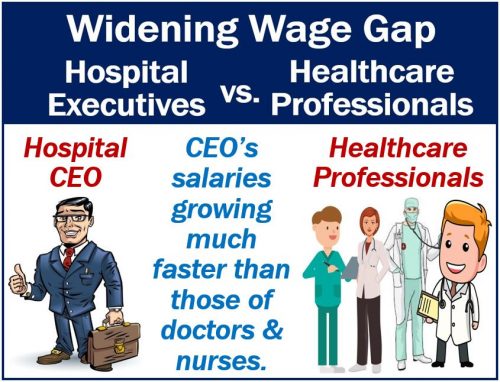The wage gap between hospital executives in the United States and healthcare professionals has been widening. In other words, the salaries of hospital executives have been growing faster than that of doctors, nurses, etc.
Randall E. Marcus, MD, and colleagues wrote about a study they carried out in Clinical Orthopaedics and Related Research® (citation below). Dr. Marcus and colleagues work at University Hospitals Cleveland Medical Center/Case Western Reserve University.
Dr. Marcus said:
“There is a fast-rising wage gap between the top executives of major non-profit centers and physicians that reflects the substantial, and growing, cost-burden of management and nonclinical worker wages on the US healthcare system.”

Regarding the salaries of hospital executives and healthcare professionals, the authors wrote the following in an Abstract: “There is a fast-rising wage gap between the top executives of major nonprofit centers and physicians that reflects the substantial, and growing, cost of nonclinical worker wages to the US healthcare system. However, there does not appear to be a proportionate increase in healthcare utilization.”
Rising costs of hospital executives
The researchers gathered and analyzed publicly accessible data. They analyzed trends in salaries for hospital administrators compared to those of nurses and doctors between 2005 and 2015.
The team focused on twenty-two major nonprofit healthcare systems across the USA. Nonprofit, in this context, refers to organizations whose purpose is other than making a profit. Nonprofits focus, for example, on education, health, trades, professions, workers’ rights, etc.
During that ten-year period, CEOs compensation increased, on average by 93%, from $1.6 million to $3.1 million.
Orthopaedic surgeons’ compensation, on the other hand, over the same period rose by just 26%. Pediatricians’ and nurses’ salaries rose by 15% and 3% respectively.
From 2005 to 2015, CEOs’ average incomes rose from three times that of an orthopaedic surgeon’s to five times. Over the same period, top hospital executives’ income rose seven times to twelve times those of pediatricians.
Compared to registered nurses’ salaries, over the same period, the difference was twenty-three to forty-four times.
Cost of management and other nonclinical staff
Dr. Marcus and colleagues also examined the trends in the numbers and costs of management and other nonclinical employees.
Across the US, the cost-burden of healthcare worker wages rose from $663 billion to $865 billion. This was also for the 2005-to-2015.
Salaries of nonclinical workers accounted for 27% of this increase, while those of management employees for 7%. Physicians’ compensation accounted for 18%.
The authors wrote:
“In 2015, there were ten nonclinical workers for every one physician.”
Wages and overall spending increased
National expenditures on healthcare rose from $2.5 trillion to $3.2 trillion from 2005 to 2015. Wages accounted for over one-fourth of the increase.
Despite relatively stable use of healthcare services over the ten-year period, wages and overall spending increased.
Recent reports have pointed out the growing wage gap between hospital executives and healthcare professionals. Reports have also drawn attention to the increasing costs of nonclinical workers in America’s healthcare system.
This new study, however, is the first to systematically analyze the wage gap and how it contributes to overall healthcare costs.
Wage gap between hospital executives and clinical staff continues to widen
The study results show a continued widening of the disparity in compensation between healthcare professionals and hospital executives such as CEOs.
The authors point out that their study cannot comment on the value of these hospital executives and nonclinical employees. However, the growth in costs “appears to outpace plausible growth in value.”
The authors wrote:
“It appears unlikely to us that the near-doubling of mean compensation to hospital executives is justified by the value added by their work.”
Accompanying Commentary
An accompanying Commentary includes a Take 5 interview with Dr. Marcus by Seth Leopold, MD. Dr. Leopold is Clinical Orthopaedics and Related Research® Editor-in-Chief. The interview focuses on the growing financial burden of nonclinical employees in America’s healthcare system.
Regarding the value of hospital executives and nonclinical workers, Dr. Marcus says:
“The value of each nonclinical healthcare worker, including executives, should be of concern to all of us and scrutinized closely by the boards of directors of these nonprofit medical centers.”
Orthopaedic surgeon or orthopedic surgeon?
According to the University of Colorado:
“You may have noticed the spelling variations of orthopedics/orthopaedics. The origins of our answer can be traced back to French physician and writer Nicholas Andry, who coined the original term ‘orthopaedics.'”
“The common use of “orthopedics” evolved in the United States over the years, yet most University and Higher Education departments maintain the traditional “orthopaedics” spelling, as does Britain. Orthopaedics is also used by the American Academy of Orthopaedic Surgery.”
Citation
“The Growing Executive-Physician Wage Gap in Major US Nonprofit Hospitals and Burden of Nonclinical Workers on the US Healthcare System,” Du, Jerry Y., MD; Rascoe, Alexander S., MD, MBA; and Marcus, Randall E., MD. Clinical Orthopaedics and Related Research®: August 10, 2018 – Volume Published Ahead of Print – Issue – p. DOI: 10.1097/CORR.0000000000000394.
